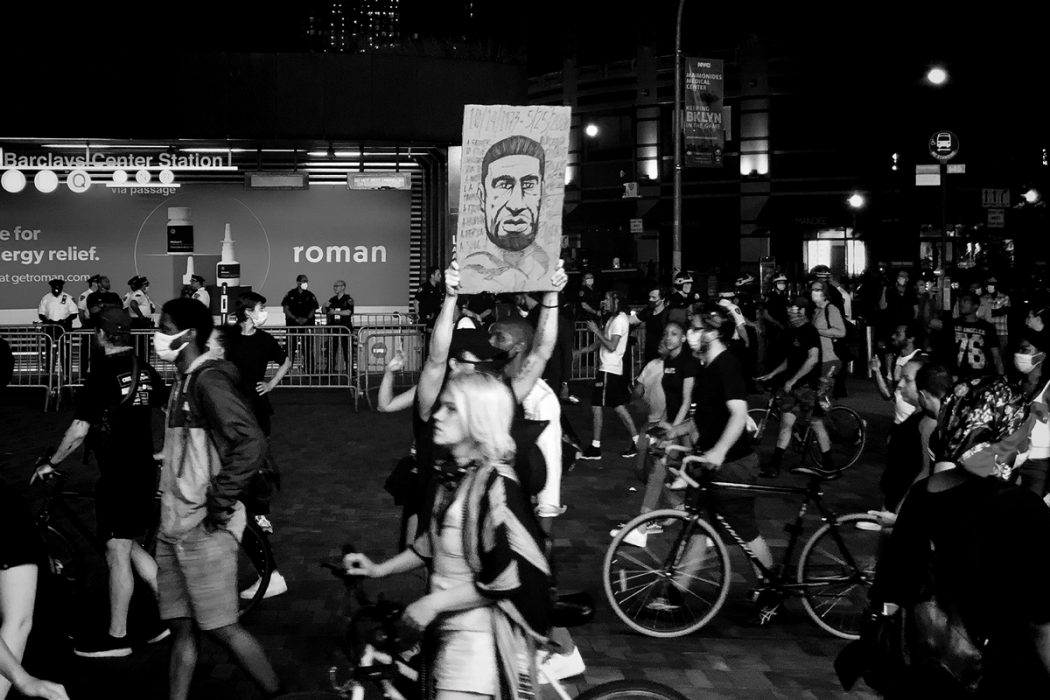As the crowd of thousands made its way east down Atlantic Avenue from the Barclays Arena in Brooklyn, a sign held up among the sea of heads, flags, and raised fists caught my eye. The sign the protester carried read “You Watched Hong Kong Now See Us.”
Many people in the United States, myself included, have been following the protests in Hong Kong since they broke out last year. We’ve seen the photographs of the masses of protesters marching peacefully in the streets of Hong Kong. We’ve seen the images of clouds of tear gas floating through the streets, of heavily armed police firing rubber bullets into the crowds. We’ve seen the iconic photograph of the police officer drawing his gun at a protester, and photographs of the police manhandling protesters to the ground to make arrests. And we’ve seen the images of Hong Kong on fire.

But I’ve been following the journalists covering the protests. Not just the photographs they make and stories they write, but the reports of journalists being pepper-sprayed, shot with rubber bullets, having lights shone into the camera lenses and faces, of them being arrested, harassed and every manner of attempts to stop them from doing their jobs.
I have even written a series of op-eds about the situation that the press in Hong Kong and mainland China face. We in the United States stood behind the journalists in Hong Kong. We saw what you were going through and railed against the attacks on the free press in the city.
But how a few weeks can change everything.
The death of George Floyd at the hands of police in Minneapolis Minnesota has unleashed a torrent of protests. Once again, I am watching scenes of protests, tear gas, rubber bullets, and arrests. But now it is not just in Hong Kong on the other side of the world, but a short walk from where I live.
And I’m not just looking at photographs and news footage. Rather, I am there myself making photographs and watching the scenes unfold in front of me. And it is not just happening in New York City, but in cities all over the United States.

And just as has happened in Hong Kong, journalists are being attacked, harassed and arrested. Since their tracking began on May 26th, the Committee to Protect Journalists has had reports of over 280 press freedom violations across the United States, including 45 arrests and detentions of journalists and dozens of reports of journalists attacked by police with pepper spray, tear gas and rubber bullets.
The US Press Freedom Tracker counts over 380 press freedom violations as of writing, more in just over a week than the total of 150 for all of 2019.The stories behind these numbers are not hard to find.
Omar Jimenez of CNN and his cameraman and a producer were arrested while broadcasting live in Minneapolis. Tim Myers, a cameraman for Channel 7 in Australia was also live on air when riot police hit him with a shield while clearing streets near the White House. Journalist Balin Brake lost an eye after being hit with a tear gas canister in Fort Wayne, Indiana, and journalist Linda Tirado lost an eye to a rubber bullet in Minneapolis, Minnesota.
There are many photographs to be found on Instagram and Twitter showing the wounds journalists have received at the hands of police while covering the protests. Others show journalists in handcuffs and being muscled around by police.

The assaults on the press have gotten so out of control in the US, that like in the case of Hong Kong, world leaders are calling for the US to protect reporters. The signatories include Australia, Germany and Turkey. Yes, Turkey, which has its own history of violence against journalists and repressing press freedom.
The Committee to Protect Journalists itself has sent a letter calling for the local authorities in the US to stop arrests and assaults on journalists covering the protests. And even the Foreign Correspondent’s Club of Hong Kong has issued a statement expressing their solidarity with journalists in the United States.
Freedom of the press is enshrined in the 1st Amendment of the United States Constitution, as it is also enshrined in the Basic Law of Hong Kong. But as the last fortnight in the United States and the last year in Hong Kong have shown, words ring hollow when they are ignored.
And laws don’t mean much when those tasked with upholding them break them. The US secretary of state may have strong words about press freedom in Hong Kong, but those words are undercut when the US’s own stance is being called into question on the world stage.

Press freedom can’t be taken for granted by anyone, no matter where you are. If the United States and Hong Kong can both be ranked as problematic places for journalists by Reporters Without Borders, what does that mean for journalism as a whole? And where is safe anymore?
Gordon Parks, the famous African-American photographer, once wrote “I saw that the camera could be a weapon against poverty, against racism, against all sorts of social wrongs. I knew at that point I had to have a camera.” But whether your tool in journalism is the camera or the keyboard, while we are all working to tell the stories that need to be told, we need to use the same tools to defend our right to do so.
We must hold those whose job it is to protect the free press accountable, no matter where the attacks happen.
